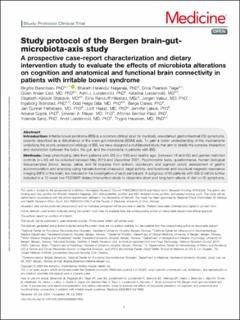Study protocol of the Bergen brain-gut-microbiota-axis study: A prospective case-report characterization and dietary intervention study to evaluate the effects of microbiota alterations on cognition and anatomical and functional brain connectivity in patients with irritable bowel syndrome
| dc.contributor.author | Berentsen, Birgitte | |
| dc.contributor.author | Nagaraja, Bharath Halandur | |
| dc.contributor.author | Teige, Erica Persson | |
| dc.contributor.author | Lied, Gülen Arslan | |
| dc.contributor.author | Lundervold, Astri | |
| dc.contributor.author | Lundervold, Katarina | |
| dc.contributor.author | Steinsvik, Elisabeth Kjelsvik | |
| dc.contributor.author | Hillestad, Eline Margrete Randulff | |
| dc.contributor.author | Valeur, Jørgen | |
| dc.contributor.author | Brønstad, Ingeborg | |
| dc.contributor.author | Gilja, Odd Helge | |
| dc.contributor.author | Osnes, Berge | |
| dc.contributor.author | Hatlebakk, Jan Gunnar | |
| dc.contributor.author | Haász, Judit | |
| dc.contributor.author | Labus, Jennifer | |
| dc.contributor.author | Gupta, Arpana | |
| dc.contributor.author | Mayer, Emeran | |
| dc.contributor.author | Benitez-Páez, Alfonso | |
| dc.contributor.author | Sanz, Yolanda | |
| dc.contributor.author | Lundervold, Arvid | |
| dc.contributor.author | Hausken, Trygve | |
| dc.date.accessioned | 2021-02-12T08:19:48Z | |
| dc.date.available | 2021-02-12T08:19:48Z | |
| dc.date.created | 2020-09-11T23:20:50Z | |
| dc.date.issued | 2020-09 | |
| dc.Published | Medicine. 2020, 99:e21950 (37), 1-8. | |
| dc.identifier.issn | 0025-7974 | |
| dc.identifier.uri | https://hdl.handle.net/11250/2727593 | |
| dc.description.abstract | Introduction: Irritable bowel syndrome (IBS) is a common clinical label for medically unexplained gastrointestinal (GI) symptoms, recently described as a disturbance of the brain-gut-microbiota (BGM) axis. To gain a better understanding of the mechanisms underlying the poorly understood etiology of IBS, we have designed a multifaceted study that aim to stratify the complex interaction and dysfunction between the brain, the gut, and the microbiota in patients with IBS. Methods: Deep phenotyping data from patients with IBS (n = 100) and healthy age- (between 18 and 65) and gender-matched controls (n = 40) will be collected between May 2019 and December 2021. Psychometric tests, questionnaires, human biological tissue/samples (blood, faeces, saliva, and GI biopsies from antrum, duodenum, and sigmoid colon), assessment of gastric accommodation and emptying using transabdominal ultrasound, vagal activity, and functional and structural magnetic resonance imaging (MRI) of the brain, are included in the investigation of each participant. A subgroup of 60 patients with IBS-D will be further included in a 12-week low FODMAP dietary intervention-study to determine short and long-term effects of diet on GI symptoms, microbiota composition and functions, molecular GI signatures, cognitive, emotional and social functions, and structural and functional brain signatures. Deep machine learning, prediction tools, and big data analyses will be used for multivariate analyses allowing disease stratification and diagnostic biomarker detection. Discussion: To our knowledge, this is the first study to employ unsupervised machine learning techniques and incorporate systems-based interactions between the central and the peripheral components of the brain-gut-microbiota axis at the levels of the multiomics, microbiota profiles, and brain connectome of a cohort of 100 patients with IBS and matched controls; study long-term safety and efficacy of the low-FODMAP diet on changes in nutritional status, gut microbiota composition, and metabolites; and to investigate changes in the brain and gut connectome after 12 weeks strict low-FODMAP-diet in patients with IBS. However, there are also limitations to the study. As a restrictive diet, the low-FODMAP diet carries risks of nutritional inadequacy and may foster disordered eating patterns. Strict FODMAP restriction induces a potentially unfavourable gut microbiota, although the health effects are unknown. | en_US |
| dc.language.iso | eng | en_US |
| dc.publisher | Wolters Kluwer Health | en_US |
| dc.rights | Navngivelse 4.0 Internasjonal | * |
| dc.rights.uri | http://creativecommons.org/licenses/by/4.0/deed.no | * |
| dc.title | Study protocol of the Bergen brain-gut-microbiota-axis study: A prospective case-report characterization and dietary intervention study to evaluate the effects of microbiota alterations on cognition and anatomical and functional brain connectivity in patients with irritable bowel syndrome | en_US |
| dc.type | Journal article | en_US |
| dc.type | Peer reviewed | en_US |
| dc.description.version | publishedVersion | en_US |
| dc.rights.holder | Copyright The Author(s) | en_US |
| dc.source.articlenumber | p e21950 | en_US |
| cristin.ispublished | true | |
| cristin.fulltext | original | |
| cristin.qualitycode | 1 | |
| dc.identifier.doi | 10.1097/MD.0000000000021950 | |
| dc.identifier.cristin | 1829311 | |
| dc.source.journal | Medicine | en_US |
| dc.source.40 | 99:e21950 | |
| dc.source.14 | 37 | |
| dc.source.pagenumber | 1-8 | en_US |
| dc.source.volume | 99 | en_US |
| dc.source.issue | 37 | en_US |
Tilhørende fil(er)
Denne innførselen finnes i følgende samling(er)
-
Department of Clinical Medicine [2043]
-
Registrations from Cristin [9482]

